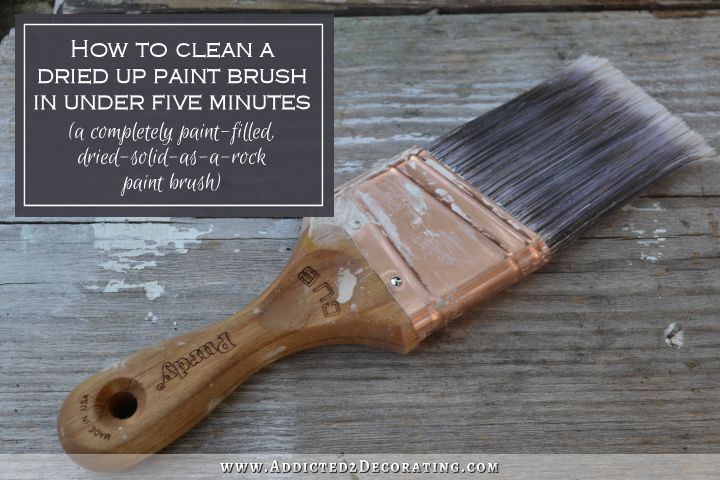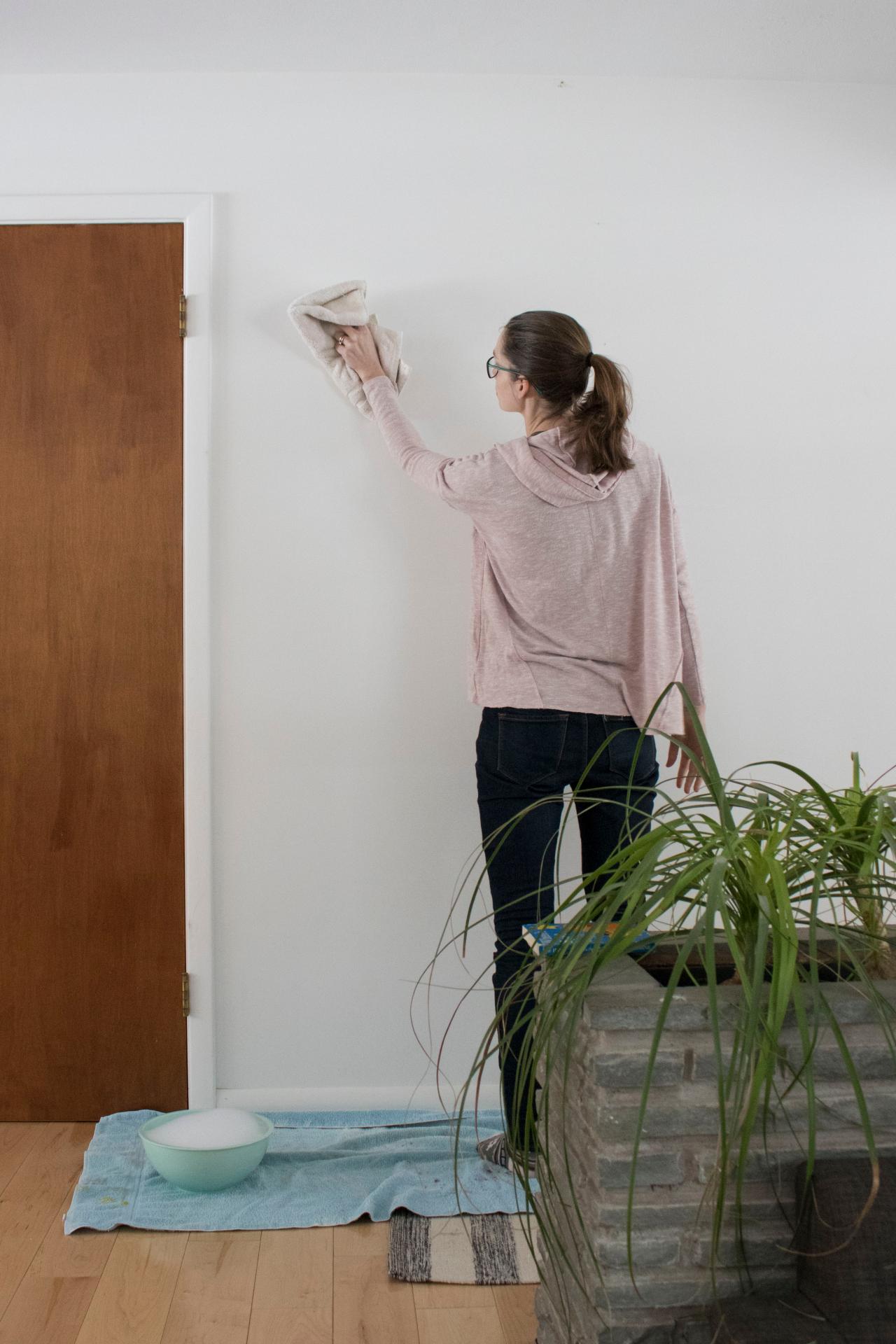Cleaning Gloss Paint Brushes
This post may contain affiliate links. If you buy a product or service from an affiliate such as Amazon after clicking a link on this website, we earn a commission from qualifying purchases.
- How To Clean Gloss Paint Brushes With White Spirit
- Cleaning Paint Brushes Safely
- How To Clean Gloss Paint Brushes Without Turps
- How To Clean High Gloss Paint Brushes
In this article, we’ll be looking at the best ways to clean paintbrushes after you’ve spent hours painting skirting boards, painting interior doors and generally sprucing up your home.
Cleaning up natural paint. Natural paints refer to those made entirely from plants, minerals, clay, or milk-protein. So long as metallic or chemical-based dyes are not added to the base, these natural paints are completely non-toxic and biodegradable. Most cleaning detergents will damage your brush's bristles, and paint stripper is strong enough to warp your brush's shape. To keep from damaging your varnish brush, stick to dish soap and water. The simpsons hit and run for mac. 2 Wash the brush with dish soap under warm running water.
A good quality paintbrush will last many decorating jobs and will help you achieve a high-quality finish. So it makes good financial sense to take care of those babies, right?
How To Clean Gloss Paint Brushes With White Spirit

(The same goes for home decorating equipment in general. If you buy the best gear you can afford, and look after it, it will last for years.)
There are a number of different paints on the market today (including eco-friendly paints) but most people use either a water-based paint or spirit-based paints.
The way to identify whether you’re using water-based or oil-based paint is to look at the cleaning instructions on the container. If it says clean with water, you’re using a water-based paint (typically low odour) and if it says clean with white spirit/Turpentine then you’re using a spirit-based paint (usually high odour).
Let’s get into the process of cleaning the paintbrushes.
How to clean water-based paint from a paintbrush
You will need:
- Old newspaper/kitchen towels
- Dry cloth
- Small bowl
- Access to a sink with running water (warm water works best)
- Washing up liquid/dish detergent
- Clothes/fabric conditioner (optional)
- Old nailbrush
1) Remove excess paint from the brush
Remove any excess paint from the brush by repeatedly wiping the paintbrush on the newspapers until hardly any paint comes off the brush. Dispose of the used newspapers normally. If you don’t have any old newspapers lying around, kitchen towels will do the job just as well.
2) Dip the brush into a small container of water
Fill a small bowl with warm water and add a tiny amount (drop) of detergent. Dip the brush bristles into the water so they are covered.

Using slight pressure, press down on the brush, bending the handle slightly to one side so the bristles are almost at a right angle to the handle. While keeping up the pressure, rotate the brush gently clockwise and then anti-clockwise to work the water into the bristles.

(Do not push down hard on the brush or you will cause the bristles to ‘splay’ and the brush will lose its structure).
3) Use a nailbrush to remove the excess paint
Lift the brush out of the water and use a small nailbrush to brush away excess paint build up on the ferrule (the part where the bristles meet the metal holding band).
Use the nail brush to brush away paint from the ferrule and towards the end of the brush.
Step 4
When the water is completely opaque, rinse out the bowl and repeat the process (usually about 2-3 times if you’ve wiped enough of the excess paint off at the start). When the water is almost clear after revolving the brush, take the brush out and using your fingers, squeeze excess water out of the bristles. Pour a small amount of fabric conditioner onto the bristles and work well in for a minute or so.
Step 5
Run the brush under clean water for a couple of seconds and dry off using a clean dry cloth. Take a piece of string and tie it to the handle of the brush so that the bristles are pointing downwards, hang the brush from a shelf until its dry. If the bristles are ‘splayed’, Wrap a piece of paper round the end of the bristles and secure it with a loose elastic band to help form the brush shape once again.

Voila! – clean brushes that won’t leave bits in your paintwork the next time you use them.
How to clean spirit-based paint from a paintbrush
Nobody likes cleaning oil/spirit based paint but the costs of a good paintbrush means that unless you are willing to throw them away every time or use poor quality brushes, you’d better learn how to do it the easy way J
Windows remote desktop iphone. You will need:
- White spirit / Turpentine
- Old newspapers
- Clean & dry jar (take any labels off in case small children get hold of it!)
- Dry cloth
- Small bowl
- Access to a sink with running water (warm optional)
- Washing up liquid/dish detergent
- Clothes/fabric Conditioner (optional)
- Old nailbrush
IMPORTANT!
As with all paints that contain spirit or oil DO NOT SMOKE while doing this. Make sure the room you are working in is well ventilated and that there are no naked flames or incandescent heaters on nearby. Better still – go outside! Turpentine is a toxic to humans and it should be stored safely away from small children as it is fatal if consumed!
Step 1
Pour one to two inches of turpentine (turps) or white spirit into a jar wide enough for your brush to fit into. Take your paintbrush and brush the excess paint onto the old newspapers until the brush contains almost no paint.
Step 2
Dip the brush into the jar and rotate it in the liquid; you will see the colour change from clear to that of the paint previously on the brush. Bend the brush slightly as you turn it so that the turpentine / white spirit works the paint loose from the bristles. Continue doing this until you can see most of the paint has been removed from the bristles.
Step 3
Remove the brush from the liquid and squeeze out any excess liquid. Paint the newspapers with the brush so that any remaining liquid is transferred onto the paper. Repeat until the brush feels almost dry. Now take a small amount of washing up liquid/dish detergent and work into the bristles of the brush. Keep adding more liquid until the whole of the bristle area is ‘leaking’ a slimy like substance.
Step 4
Now take the brush and brush out onto old newspapers again. Once most of the slimy liquid has been removed, add some more washing up liquid/dish detergent and work back into the brush. Now run the brush under warm water to remove the remaining detergent and using your fingers, squeeze excess water out of the bristles.
Pour a small amount of fabric conditioner onto the bristles and work well in for a minute or so. Run the brush under clean water for a couple of seconds and dry off using a clean dry cloth.
Take a piece of string and tie it to the handle of the brush so that the bristles are pointing downwards, hang the brush from a shelf until its dry. If the bristles are ‘splayed’, wrap a piece of paper round the end of the bristles and secure it with a loose elastic band to help form the brush shape once again.
Clean-up (Important)
Cleaning Paint Brushes Safely
Put a lid on the jar and store well away from small hands – in about a week or two, the paint sediment will have sunk to the bottom of the jar leaving clear white spirit/turpentine to be used again. DO NOT UNDER ANY CIRCUMSTANCES POUR THIS DOWN A DRAIN OR IN A RIVER – IT IS HIGHLY TOXIC.
If you are not likely to re-use it, leave the lid off and leave outside away from any heat sources until the liquid evaporates. Any newspapers that have been used can be either burned or taken to your local refuge centre where they should be placed in the used paint container.
One of my readers asked me if it was a good idea to put their wet paintbrushes and rollers in plastic bags tokeep them fresh when you need to stop painting.
Early on in my career, I wrapped mine that way when I had a delay incontinuing the paint job. Well, I was surprised to find that the brushes were pretty dried out in spots and theroller cover was hopelessly stuck to the frame! Was I mad! Did I do something wrong?
Plastic wrap or plastic bags are not the ideal brush and roller wrapping material!
Plastic doesn't work well for a couple of reasons:
- It's hard to seal a plastic bag well unless you put the entire roller or brush inside.
- Even then, the excessive air in the bag still allows drying to take place.
- Wrapping a brush or roller in plastic wrap gives a better seal but is messy to deal with.
- Thin plastic wraps can be slightly porous, allowing moisture (from latex paints) or solvents (from oil-based paints) to escape, hardening the paint on the brush/roller.
My solution? Aluminum foil instead of plastic!
Why foil? Aluminum foil is virtually airtight when folded around a brush or rolled onto a roller and conforms to the shape perfectly, leaving minimal air for drying. A standard width piece cut about 12' long will cover a standard size brush or roller.
Be sure to leave lots of paint on the roller orbrush before wrapping to get the longest storage time!
How well does it work?
I have wrapped rollers covered with Kilz fast drying primer and had them still useable for a few days. I prefer to use thicker heavy-duty foil, which is less likely to tear. It is only a few cents more per roll than regular foil but well worth it. If you think your rollers will be in for some abuse once wrapped double-wrap them!
Want your brushes and rollers to last even longer? Refrigerate them!
How To Clean Gloss Paint Brushes Without Turps
If you want those wet brushes and rollers to last even longer, throw… sorry… place them in the refrigerator. Then their useful life can increase by weeks! In fact, I have found month-old rollers still useable, buried behind the veggies in my fridge. Not that it makes my wife very happy… but that's another story!
The freezer?? Not for latex paints!
How To Clean High Gloss Paint Brushes
Some folks think putting brushes and rollers in the freezer is even better. For oils, it doesn't seem to have a negative effect. But for latex paints, freezing can cause the paint to become stringy and semi-solid. These little bits of clotted paint will transfer to your work, leaving little lumps on the surface and making a general mess. Stick to the refrigerator!
